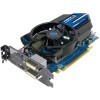- Qualcomm Launches Snapdragon 4 Gen 2 Mobile Platform
- AMD Launches Ryzen PRO 7000 Series Mobile & Desktop Platform
- Intel Launches Sleek Single-Slot Arc Pro A60 Workstation Graphics Card
- NVIDIA Announces Latest Ada Lovelace Additions: GeForce RTX 4060 Ti & RTX 4060
- Maxon Redshift With AMD Radeon GPU Rendering Support Now Available
Sapphire Radeon HD 5770 Vapor-X

Of all the current mid-range graphics cards on the market, the Radeon HD 5770 from AMD has proven to be one of the best. It offers great performance, and has other perks such as DirectX 11 and Eyefinity support. With its Vapor-X model, Sapphire has improved the card in numerous ways, including power consumption and temperatures.
Page 11 – Overclocking Sapphire’s HD 5770 Vapor-X
Before tackling our overclocking results, let’s first clear up what we consider to be a real overclock and how we go about achieving it. If you read our processor reviews, you might already be aware that we don’t care too much for an unstable overclock. It might look good on paper, but if it’s not stable, then it won’t be used. Very few people purchase a new GPU for the sole purpose of finding the maximum overclock, which is why we focus on finding what’s stable and usable.
To find the max stable overclock on an ATI card, we stick to using ATI’s Catalyst Overdrive tool. Compared to what’s available on the NVIDIA side, it’s quite limited in the top-end, but it’s the most robust and simplest solution to use. For NVIDIA, we use EVGA’s Precision, which allows us to reach heights that are in no way sane – a good thing.
Once we find what we believe might be a stable overclock, the card is put through 30 minutes of torture with the help of OCCT 3.0’s GPU stress-test, which we find to push any graphics card harder than any other stress-tester we’ve ever used. If the card passes there, we then further verify by running the card through a 2x run of 3DMark Vantage’s Extreme setting. Finally, games are quickly loaded and tested out to assure we haven’t introduced any side-effects.
If all these tests pass without issue, we consider the overclock to be stable.
Overclocking Sapphire’s Radeon HD 5770 Vapor-X
Though Sapphire’s Vapor-X card is technically pre-overclocked, it has the weakest one I’ve ever seen. As the reference HD 5770 has fairly good overclocking-abilities, I was hoping that coupled with the improved chokes and far superior cooler, that our overclocking headroom would increase, and it did. While the stock clocks are 850MHz/1200MHz, the top overclock here was 960MHz/1400MHz. That’s a major improvement over the reference card’s overclock of 910MHz/1225MHz.
As odd as it is, though, the performance we saw after the overclock wasn’t actually that great compared to what we’d expect. Let’s face it… 110MHz to the core and 200MHz to the memory is a huge boost, and while we continued to see improved performance the higher we went, the benefits were slow to grow. One reason for this may be the limited memory bus, at 128-bit (compared to 256-bit of the larger cards), because common sense would tell me that we should be seeing far larger gains than this:


Still, for completely stable performance, the results are fantastic, especially as the card managed to retain reasonable temperatures throughout all testing (~75°C). At that temperature, that’s actually better than what the reference card can manage at stock speeds, so if that’s not an impressive accomplishment by this card, I’m not sure what is.
Support our efforts! With ad revenue at an all-time low for written websites, we're relying more than ever on reader support to help us continue putting so much effort into this type of content. You can support us by becoming a Patron, or by using our Amazon shopping affiliate links listed through our articles. Thanks for your support!





